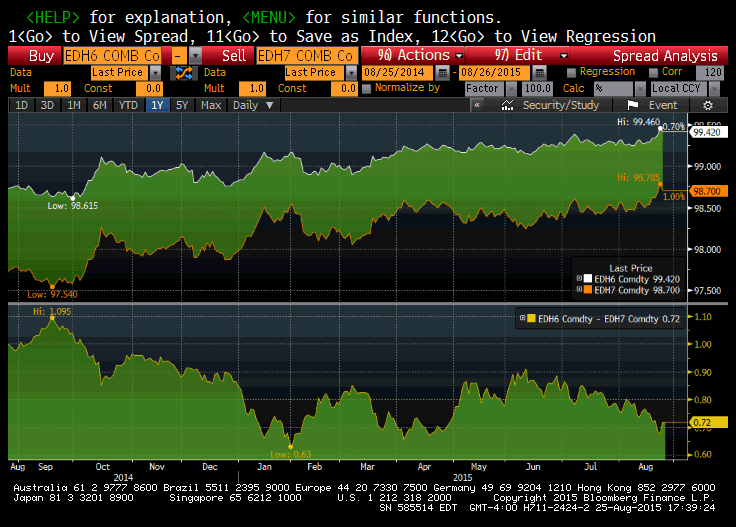To say the markets have been roiled in the past few days is an understatement. The financial press has focused on US and Chinese equities, and to a lesser extent, on crude oil. Clearly, the US stock market is a huge factor in global wealth. From the end of July US equities probably lost a total of $2.5 trillion of market cap, so with GDP at around $17.7 trillion that represents around 14% of US GDP. In the grand scheme of things, it can cause a reverse wealth effect, and depress spending going forward.
But as we know, it’s not just global stock markets that have caused pain. Prior to the stock market turmoil, most commodities and emerging market currencies have been under severe pressure, and corporate bond spreads have been steadily increasing. These factors represent a tightening of financial conditions in that asset prices (and the income streams derived therefrom) decline in relation to the total amount of debt and other overhead. I had said in previous posts that it was unlikely the Fed would hike, and that was well before the turbulence of the past few days. Now I think it’s even more unlikely that the Fed moves this year.
Let’s check pricing implied by Eurodollar futures. The eurodollar contract represents the interest rate of three month libor at future points in time. The peak one-year Eurodollar calendar spread is now March 2016 to March 2017, at 72 bps. (chart below) The previous peak one year spread was December2015/December 2016, which is now 69.5. The point is that these spreads are near new lows for the year. In a simplistic sense, one can look at the one year spread as a proxy for the expected amount of tightening over a given year. There are eight Fed meetings per year. In the last tightening cycle from 2004 to 2006 the Fed hiked at every meeting, ¼%, so a total of 200 bps per year. The spread now is showing less than three ¼% hikes over the year, and that’s for the PEAK spread.

In another indication that the market perceives the Fed as being handcuffed, consider April 2016 Fed Funds, which trade 9960.5. The expiring August contract is 99.86. These contracts price to what is called the Fed Effective Rate, a daily average of Fed Funds which is really what the Fed more or less controls. The August contract at 99.86 represents a rate of 14 bps. Given that the April contract is almost exactly 25 bps away (1/4% higher in yield), one can say that the market is only pricing certainty of one hike by April, and there are FIVE FOMC meetings between now and then. In other words, the market continues to wring out the odds of significant Fed tightening.
This weekend is the Kansas City Fed’s Jackson Hole Symposium, which has previously been the venue for important policy clues. The Fed’s Vice-Chairman Stanley Fischer will speak on Sunday. Those who are hoping that the Central Bankers of the world are going to ride to the rescue of global equity markets should temper their expectations. As we can see, US interest rate markets have already scaled back tightening odds. Monetary policy as a tool to spur asset prices is losing efficacy.




